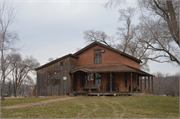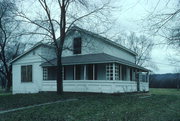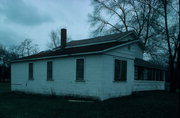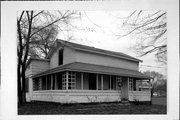| Additional Information: | A 'site file' exists for this property. It contains additional information such as correspondence, newspaper clippings, or historical information. It is a public record and may be viewed in person at the Wisconsin Historical Society, State Historic Preservation Office.
Emilie Rolette was born in about 1810, the daughter of Joseph Rolette. As Joseph Rolette was one of the most prominent fur traders in the area, his daughter Emilie was born into a relatively privileged family. In 1831, Emilie Rolette married Alexander Hooe who was serving at Fort Crawford as a Captain in the 5th Infantry. Alexander Hooe eventually rose to the rank of Major and served as Post Commander at Fort Crawford for a time in 1846 and 1847. At about this time, Alexander and Emilie Hooe had constructed the red brick house at 213 Villa Louis Road where they lived with their three children. By 1853, Major Hooe had died leaving Emilie a widow. After the last U.S. soldiers left Fort Crawford in June of 1856, Emilie Hooe lived in the commandant’s house and served as caretaker of the fort. According to the US Army Corps of Engineers 1981 report on the built resources of St. Feriole Island, Emilie Hooe “became a U.S. Agent, taking care of the fort during the ever more frequent absences of the garrison, and lived in the commandant’s residence rent-free.” During this time, when an irregularity in the government’s title to the Fort Crawford military tract led local businessmen Ira Brunson, B.W. Brisbois, and Cyrus Woodman to make plans to seize control of the property, Emilie sent warnings to the U.S. Secretary of War in an effort to protect the federal government’s holdings. When the county sheriff attempted to enter the Fort on the businessmen’s behalf, Emilie refused him admittance, following which the sheriff forcefully commandeered the property. Emilie was evicted from the Fort in 1858. From 1856 to 1858, Emilie Hooe’s unique role as a female agent charged with the care of a federal military fort renders her a significant figure Prairie du Chien’s early history.
2020: This one and one-half story, front gabled, red brick house was built circa 1845. The main house has been modified some on the interior, with walls moved, and the wrap around porch which is on the front/west façade, and side/south façade, though not original, is likely of a similar design as the original. The doors and windows appear to be original. A 20th century shed roofed addition spans the entire north side façade.
The house was built by Emilie Rolette Hooe, in the year she acquired the property, circa 1845. Her father was a prominent fur trader in Prairie du Chien, and she would have been a woman of some status. She married Captain Alexander S. Hooe of the 5th Infantry stationed at Fort Crawford in 1831, however, he died in 1847 from injuries he sustained during the Mexican War. Emilie Rooe was left with four children to care for. Captain Hooe had temporarily been commander at Fort Crawford at the time of his death, and they were living in the commandant’s residence. She because the U.S. Agent of Fort Crawford in care of the fort during the increasingly frequent absences of the garrison. Though she repeatedly warned the Secretary of War that local businessmen were trying to take over the fort, she received little assistance, and by 1858 she was evicted by the local businessmen’s group from Fort Crawford. It was during this time she sold her house to Paulina Hurd, an apparent friend, in 1853. |
|---|
| Bibliographic References: | Scanlan, Peter Lawrence. Prairie du Chien: French, British, American. Menasha, WI: George Banta
Publishing Co., 1937.
Richard H. Zeitlin, Prairie du Chien: Urban Consolidation and Decline, 1858-1930. Flood Damage Reduction Project (St. Paul, MN: US Army Corps of Engineers, 1981). |
|---|





